Archive for January, 2006
January 23, 2006 at 5:30 am · Filed under Places to go
Looking on a map you might wonder about the remoteness of this park we’re in. We are 85 miles from Gila Bend, which is itself a dot on the interstate highway in the midst of a lot of desert. Is there anything to do here, anything to see that we haven’t seen in other desert parks (Death Valley, Joshua Tree, Anza-Borrego, Big Bend)?
The answer is of course “yes.” I am constantly amazed at the diversity of deserts. This place is nothing like Anza-Borrego (which was nearer the Mojave desert). Here we are in the Sonoran desert, the only place where the iconic Saguaro cactus grows ““ the one with the big arms that every associates with American deserts. In fact, there are forests of Saguaro here, along with the Organ Pipe cactus that the park is named for, and other creatures that live only in this one place.
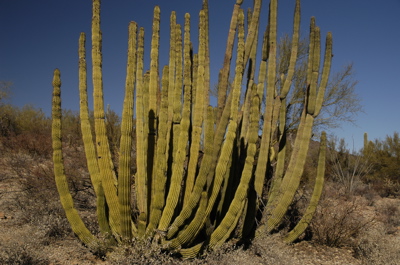
Probably the most famous is the Quitobaquito Desert Pupfish, which lives only in one place in the world, Quitobaquito Pond, a little spring just a few miles from here. Talk about endangered. This lively little fish has to survive in a little wet spot in the middle of a big desert, and if the pond has a drought, or if somebody introduces an invasive plant or animal, or if pollution gets too bad ““ they’re gone. The Desert Pupfish is a symbol of endangered creatures everywhere.
The Tohono O’odham Native Americans are another unique feature of this area. They have been here for centuries, and they still maintain many of their traditional practices, foods, and crafts. I am looking forward to driving through their nation on Rt 86 tomorrow. I’d like to try some of their prickly pear preserves, among other things!
In many of the desert parks you can find excellent viewing of the night sky. The stars in Anza Borrego were great, but here they are absolutely stupendous. Last night was crystal clear and the only light pollution was from Sonoyta, six miles away in Mexico. The stars were breathtaking just with the naked eye. (Too bad the temperature plunged from mid-70s to about 45 just a couple of hours after sunset!)
And finally, there’s the educational aspect of desert National Parks. No matter how many we go to, we always learn and appreciate more about the desert and the living things that have inhabited it, whether people, animals, or plants. This morning, we learned quite a bit from a simple 1.2 mile hike.
The nature of our border problems has changed some of this park. For example, roads are closed in some places. This meant we couldn’t go see Quitobaquito Pond. (But there is a small pond near the Visitor’s Center which contains a transplanted community of pupfish.)
Hiking around, we spotted a pair of large blue flags hanging off a pole. These are markers for “humanitarian stations” for undocumented aliens ““ e.g., emergency water for border crossers. Park staff and border patrol call them “UDAs”. Too often they show up to find a new life in America, abandoned in the desert and not carrying nearly enough water or proper clothing for a 100 mile hike through lands that routinely reach 110 degrees in the summer. At other stations, the UDAs can avail themselves of solar-powered call boxes to call for help.
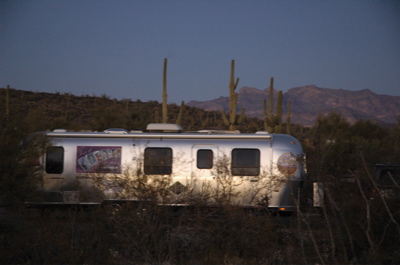
At night in the winter, the temperatures can be equally challenging. I guess we were spoiled by the mildness of Borrego Springs. Here, the wind comes up around 7 pm and the temperature plummets. We were forced to dig out all the warm clothing we have for the evening amphitheater program. We sat through “Intern Dan’s” talk while wearing two shirts, fleece, jacket, hat and gloves, and sitting on a towel to insulate against the cold benches. The rest of the audience was similarly dressed ““ we looked like a winter skating party.
Intern Dan gave us a fine presentation on the sounds of the desert animals. He’d play a sound and then have us guess which one it was. We were able to identify almost all of them (except the T-Rex he threw in as a curveball): great horned owl, coyote, mountain lion, Anna’s Hummingbird, javelina, even the silence of the jackrabbit. Emma, sitting in the front row, thought it was great fun.
The batteries are dead again. I ran the generator for 3.5 hours yesterday, and the batteries were mostly re-charged, but the burden of the furnace running frequently this cold night has been too much. I’m sitting here at 5:30 a.m. and I can hear from the whine of the furnace motor that we are out of power. The battery status light on the monitor panel is blinking red. We won’t be able to run the water pump this morning. Very frustrating.
We are leaving today, so I suppose I can take a shower after we are hitched up (with the truck running to supply power), but I can see we are going to have to come up with a better solution for boondocking nights in the cold desert.
January 22, 2006 at 8:33 am · Filed under Uncategorized
All along I-8 through southern California, the nearness of Mexico is readily apparent. It lurks across the border, sometimes only a few hundred feet away, sometimes a few miles. We have seen dozens of Border Patrol vehicles along the roadside, and we have passed through checkpoints along lonely roads near Anza Borrego, Yuma, and Organ Pipe Cactus National Monument.
From I-8 you turn south at Gila Bend, a tiny desert town that one might think would forever be a speck on the desert. A great place to “eat food, get gas” before heading somewhere else. But even Gila Bend is starting to feel the impact of Phoenix’s burgeoning suburbs 50 miles away ““ the newspaper is printing optimistic articles about how locals stand to get rich quick selling desert tracts to Phoenix commuters.
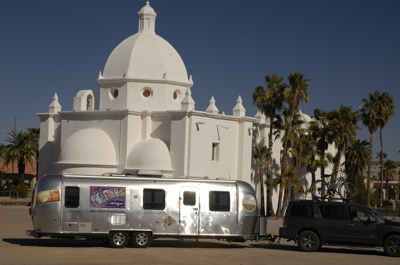
We stopped in the town of Ajo along Rt 85, expecting that it would be yet another dying desert town of the southwest. Ajo is a relic of copper mining, a town left over when the giant open-pit mine was shut down in 1985. But this little town is a surprise. It is still alive, with families enough to fill a small high school, a marvelous Spanish Colonial Revival-style plaza in the center, and a historic district filled with tiny copper miners’ bungalow homes. There is a historical museum, a downtown filled with shops, three real estate agencies, and several beautiful whitewashed stucco churches in the Mission style.
Ajo is a landlocked town, destined never to grow. It is surrounded by Air Force testing range to the north, the Cabeza Prieta National Wildlife Reserve to the east, the Tohono O’odham (Native American) Nation to the east, and Organ Pipe Cactus National Monument to the south. It’s the perfect place for someone who wants to become a desert rat, retire cheap, or who wants to live free of the pressure of rising real estate costs and sprawl. You can buy a fixer-upper for $40,000 and live in the endless sunshine and wide-open space.
The Mexican influence is apparent here, too, with “Mexican Insurance” signs all along the highway strip in Ajo, and a strong Mexican population living alongside the Border Patrol officers and Sheriff’s Department officers who make up a large portion of Ajo’s community today. Since 2001, the general beefing-up of the border has resulted in a swell of law enforcement in border towns, and Ajo is the nearest town to the crossing at Lukeville.
From the campground in Organ Pipe Cactus National Monument, we can see the lights of Mexico at night, but they are mostly from cars in the tiny border town of Sonoyta, six miles away. There’s not much on the southern side until you get to Puerto Peñasco (Rocky Point) on the Gulf of California, 60 miles away. The volunteers here in the park organize a weekly market run to get food there, which explains why the presenter at last night’s amphitheater show had fresh shrimp for dinner, here in the middle of the desert.
I was tempted to suggest we go over the border too, just for a look-see, but the nearest spot to get Mexican insurance is back in Why, 26 miles north. There’s too much to do right here in the Monument to justify spending that amount of time in the car today. We will only be here two nights before we head to Patagonia.
Our batteries are dead this morning. We boondocked in a Yuma parking lot on Friday night, and there’s no electric in this campground, so Saturday night was a second night without plugging in. Overnight temperatures here in the clear desert nights have been in the 40s. With the furnace running both nights, the batteries have been drained to a bare minimum. The refrigerator’s control board is still working, but the propane detector gave up this morning, and the water pump is pretty much not pumping anymore.
It’s clear that the trailer does not recharge well from the truck. I believe that the voltage output from the truck is not ideal for re-charging batteries. So even though we towed for three hours yesterday it didn’t do much. Even still, the generator would have saved us, but this park has unusual generator hours: noon to 4 pm. We arrived at 3:40 pm.
There’s nothing for it but to wait until noon and run the generator for the full four hours we are allowed. I’m glad we have a moderately quiet Honda eu1000i, but still I’d rather have solar. This is at least the third time we’ve been caught low on power, waiting for generator hours to get charged back up. Eleanor and I have become convinced that for full-timers who want to visit National Parks (which often do not have electric sites), there is no substitute for solar panels and a good-sized battery bank.
January 20, 2006 at 3:33 pm · Filed under Uncategorized
Hit the road today. That slow leaking tire turned out to have a nail in it. We must have got it between San Diego and Anza Borrego, because I had to put 10 lbs of air in it before we left Anza-Borrego. Fortunately, Mike has air-powered tools and big hydraulic jacks. He had that tire off in minutes, and Discount Tire put a patch in it in less than 15 minutes.
For good measure, Mike insisted on checking the torque on all our lug nuts (which were fine), increasing the air pressure to 65 psi on all tires (we were using 55 psi, but a look at the manual showed that was a bit low), and checking the battery water levels too. It’s a great feeling to depart with all those things checked.
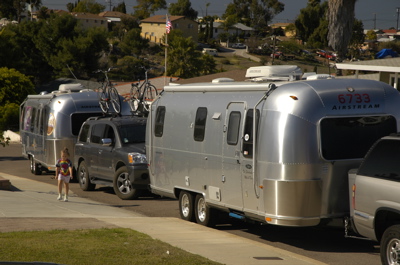
Departing Mike & Terry’s in a mini-caravan
I-8 was beautiful today. Couldn’t ask for nicer scenery or weather. At 4000 ft near Jacumba it was only 47 degrees, but by the time we got back down to sea level in Ocotillo it was a balmy 70 again. We parked for a couple of hours to have lunch, and to get online to book some air tickets for late March (from Florida, where we expect to be by then), and then proceeded to Yuma, AZ.
We’re boondocking it at a parking lot with a bunch of other RVs for the night. Eleanor is off re-stocking our groceries with Emma while I catch up on stuff, and then tomorrow we’ll head directly to Organ Pipe Cactus National Monument. It’s in the middle of nowhere, right on the Mexican border, and I expect we will have neither cell phone service nor Internet, so our next update may be after the weekend. But if I can get online sooner, I’ll post an update from that remote desert park.
January 19, 2006 at 8:31 pm · Filed under Uncategorized
One last day in San Diego before we hit the road again. It has been great here, and I’m sure we will return. The past week of downtime has given us a chance to reflect on what we are doing, but surprisingly there isn’t much we want to change about our trip at this point. Mostly the week’s hiatus gave us a chance to think about what to do next, and so we’ve come up with some really interesting plans that I’ll tell you about later.
Mike took us over to Cabrillo National Monument for a tour, as promised. I was amazed at the stunning panoramic views of San Diego available from Point Loma!
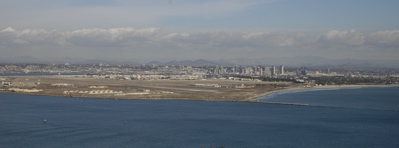
The monument is more than one might expect. There’s a very interesting interpretive center with history of Cabrillo’s explorations up the California coast, a Visitor Center with the awesome view, a lighthouse, grey whale-watching area, and more. While we were there, a group of docents were giving talks in period costume. It was a great visit, which we topped off with a Mexican dinner and ice cream with Mike and Terry.
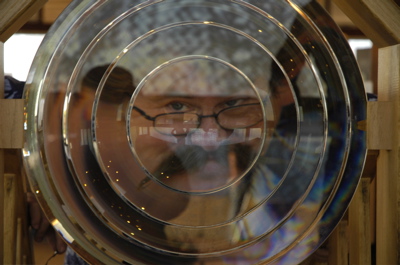
Mike looks through a fresnel lens in the Visitor’s Center.
Sam Halderman, who we met in Borrego Springs, reports via email that the winds along I-8 to El Centro were fierce today. He thinks we’ll find better towing conditions on Friday. If we get out there and the wind is still high, we’ll have to slow down or even find a spot along the way to park overnight.
I’ve noticed that the rear curbside tire of the Airstream has lost a lot of air this week. We definitely have a slow leak. Mike will help me take it off tomorrow and we’ll probably bring it over to the local tire shop in the morning before we hit the road. Much better to deal with it here than before we get out in the desolate stretches of I-8 in eastern California and Arizona.
January 19, 2006 at 8:29 am · Filed under Uncategorized
OK, we’re back from our break and prepping to head out again. Tomorrow we’ll take the drive down I-8 and begin the first eastbound leg of our trip. But today we have a few more things to do in San Diego, including a tour of Cabrillo National Monument with Terry & Mike. Terry works there, so we are looking forward to the “insider’s tour”. I’ll post photos late tonight or tomorrow.
January 18, 2006 at 12:10 pm · Filed under Uncategorized
Yes, he really did come all the way from France to the California desert … and missed us! But at least he got a picture to prove he made it. I just got this via email today:

Bruno’s Airstream blog can be found here. If you can’t read French, just click the button that says “English version”.
January 18, 2006 at 11:07 am · Filed under FAQs
Without a doubt the number one question I get from working people who want to travel by RV is, “How do you get online?”
The short answer is, “Any way I can.” Since we travel a lot, we can’t count on any one method of Internet access to work all the time. And since getting online is absolutely mandatory for me to do my job, we do what ever it takes to find the Internet, even if it means hitching up and moving onward. Sometimes that means a compromise between where we’d like to be and where we must be.
Normally, I use a cellular Internet system called “Internet in Motion” to get online. It’s basically a little black box that runs off the 12v system in the Airstream. With it, I can get online anywhere there is a cellular signal. This service costs $60 per month for unlimited use. The really nice thing about this system is that it can be left on even when in motion, so the Internet is always available. Eleanor gets online from the passenger seat while I’m towing, to look up information (weather radar, campgrounds, parks, etc). The downside, of course, is that if there’s no cellular signal, it can’t work.
Satellite is an excellent option for people who like to really roam to out-of-the-way places. It has the advantage of working anywhere you can see the southern sky, after about five minutes for the dish to orient itself. The equipment is more expensive– about $5000 installed. Monthly charges are about the same as cellular. The other thing to consider is that the satellite modems require AC power, which means you have to either be plugged in or have a big battery bank and inverter.
If we can’t get online with our IIM system, we run down the list of alternatives:
1) Is it really important to get online during our stay, or can we just pack the laptops and catch up later?
2) Is there a cyber cafe or other wireless hotspot nearby?
3) Can we borrow an office nearby with an Ethernet (wired) connection? Or, can we disconnect someone’s computer from their Internet connection for a few minutes?
4) Does our Verizon cell phone work? If so, we can connect a cable to it and get online that way.
5) Can we borrow a phone jack and dial in? (We rarely are reduced to this level, fortunately.)
The point is that it helps to have multiple ways to get online. There are no perfect, one-size-fits-all, guaranteed ways to get online. Sometimes you’ll just get skunked, as has happened to us many times. It can be frustrating that the best places to be are often the ones with no cell phone or Internet services, but we regard that as a sign that we should take a day off and go hiking!
If this sort of thing interests you, you should check out the new Digital RV Forum. It’s all about digital technology in RVs. The forum just launched on December 28 2005, and I’m one of the forum moderators. Post a question there if you have one!
« Previous entries ·
Next entries »








